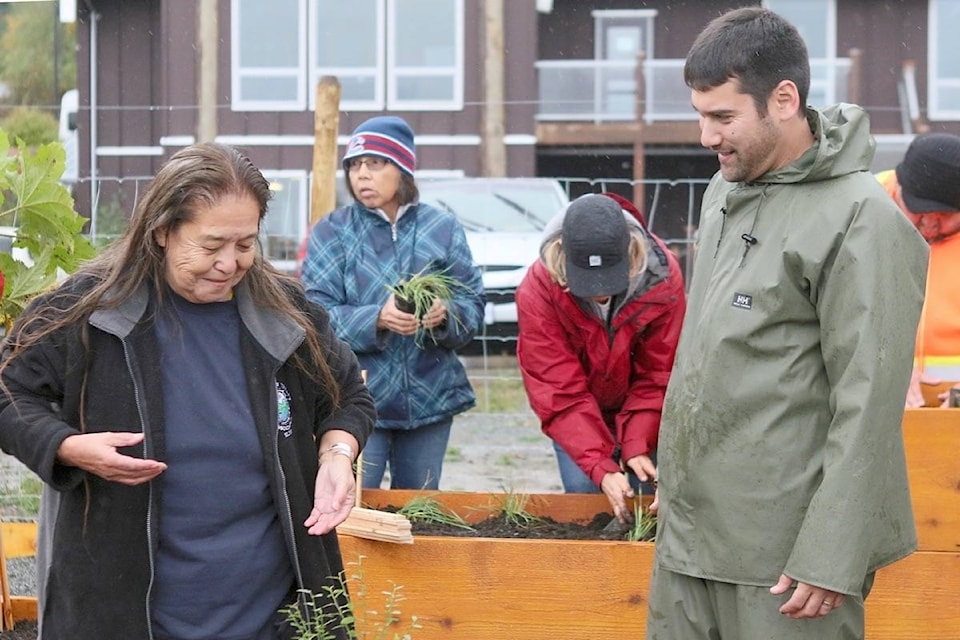A Garden of Spiritual Healing built next to the Snaw-Naw-As Health Centre looks to bring food and knowledge to the first nation.
The garden, created through a partnership between the Snaw-Naw-As and Vancouver Island University’s Mount Arrowsmith Biosphere Region Research Institute (MABRRI), has now reached phase one of a three-year plan created by MABRRI research and community engagement co-ordinator Graham Sakaki in conjunction with many and ongoing consultations with first nation members.
With vegetables such as tomatoes, carrots, potatoes, lettuce and broccoli having been grown and harvested by elders and other members of the community for use by the community, and also native plant species with the goal of learning and maintaining elder knowledge about local plants, the garden has seen a positive first year, making Sakaki and health centre director Donna Edwards excited for the many other goals they have for the garden.
The goals include developing programming to teach growing practices, culinary skills, traditional uses of local plants and how to find them locally, and much more.
But at its heart, the goal of the garden has been to help feed the community and pass on elder knowledge, said Edwards and Sakaki.
This vision comes from the late Snaw-Naw-As Chief David Bob.
“One of the things about Dave is he fed the people, so he was having elder’s luncheons, he was inviting guests to the elder’s luncheons, he was having community dinners,” said Edwards.
He was also keenly aware of a need in the community to have fresh, inexpensive produce available, especially for those who were stretching their money by buying things like KD and noodles in bulk and who couldn’t afford produce, said Edwards.
While the first nation had other programs, including a Foodshare program, coming to the community for a time, those did not last, Edwards said.
The programs revealed, however, a need for the produce and for knowledge about how to prepare it.
Through one partnership, Bob would distribute produce by leaving it on the picnic table at his house and having those who wanted it come to pick it up, Edwards said.
“He noticed that people would take everything but the squash,” she said, leading to the discovery that people didn’t know how to use it.
“He said we need to educate the people on what that food is so that they can expand what they’re having for their daily diet of fruit and vegetables.”
While that was one plan, Bob also spoke with Sakaki about creating a communal garden that the community could use to teach the younger generation about traditional language and knowledge of native plant species.
“Dave spoke to his vision of this native plant garden where the community members could come, see the plants, learn about the plants and then go gather them from somewhere else, from their natural habitat,” Sakaki recalls of a meeting about two years ago.
While that effort became the subject of Sakaki’s master’s thesis, the community pushed for the need for fresh produce once again. So the garden project pivoted to include that need as well.
“Whenever we ran our programs, (Dave) would always say to me, ‘We’re not going to offer what we think the community wants. The community is going to tell us what they want, and we’re going to give them what they ask for,’” said Edwards, pointing to the garden as an example of that wisdom.
Indeed, elders began growing veggies even before construction on the garden started in May, 2017.
“We just had to start creating garden beds immediately,” said Sakaki. “Every time we placed one or two, the next week (people said), ‘We need more, we need more.’”
Through the garden, elders were able to feed community members at several lunches, including a final harvest celebration in the summer, as well as distribute produce as Bob had done, said Sakaki.
Introduction of the native plant species, including huckleberry, blackcap, devil’s club and coastal strawberry, took place in the fall and is already yielding some revealing discoveries.
For instance, soapberries, which had been popular in the first nation for use in what’s called indian ice cream, can’t seem to be found on the Island anymore.
“The one that comes up probably every time we talk about the garden is the soapberries,” said Edwards.
It’s a plant Edwards and many others would like to see introduced to the garden.
There are many more additions planned and hoped for for the garden, with Sakaki and Edwards continuing to look for funding for those next phases.
Some of the plans include building a traditional cooking pit and a smokehouse; the development of growing, cooking and traditional practice programming; irrigation; and a therapeutic portion of the garden meant for community members to enjoy being amongst only native plants.
But already, Edwards said, Bob would be very proud of the garden.
“This was… a dream that’s become a reality now,” said Edwards.
Send news tips to:
